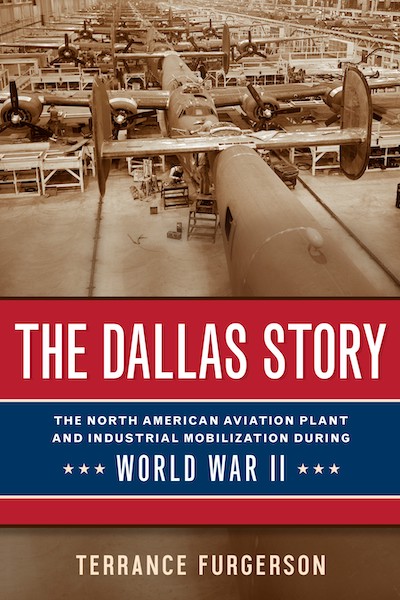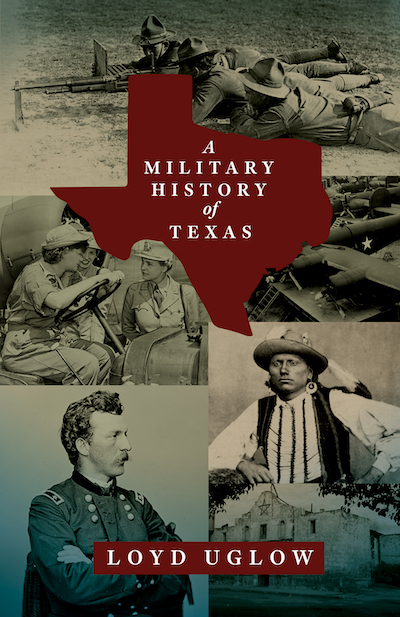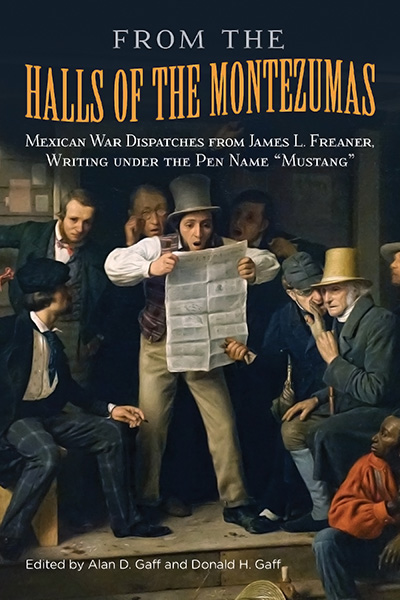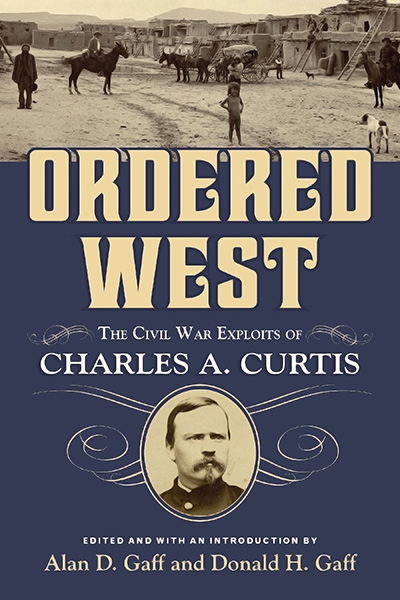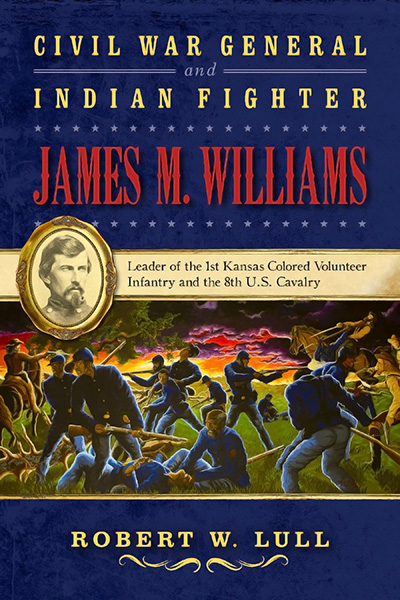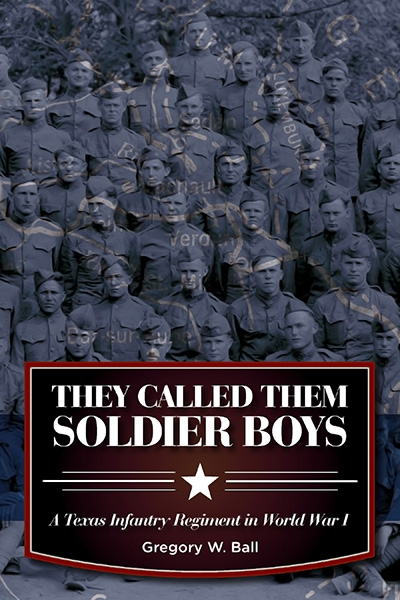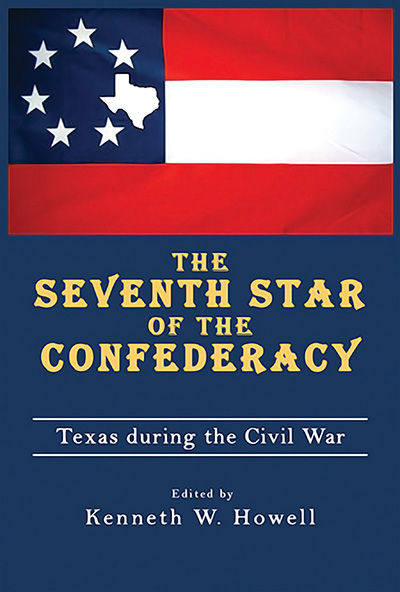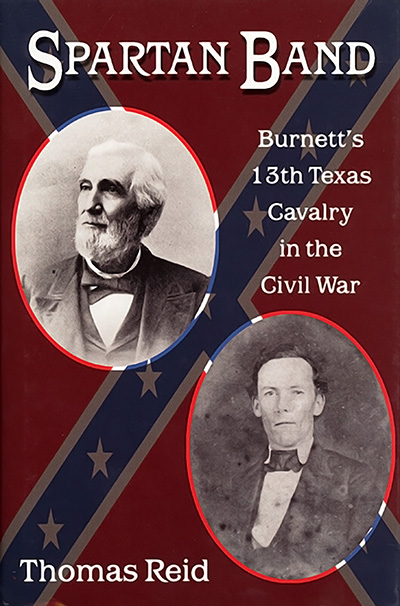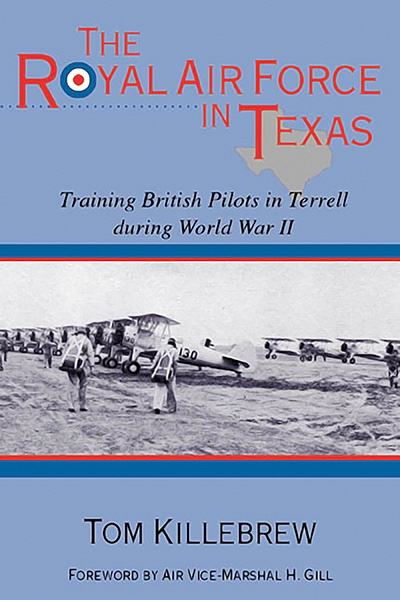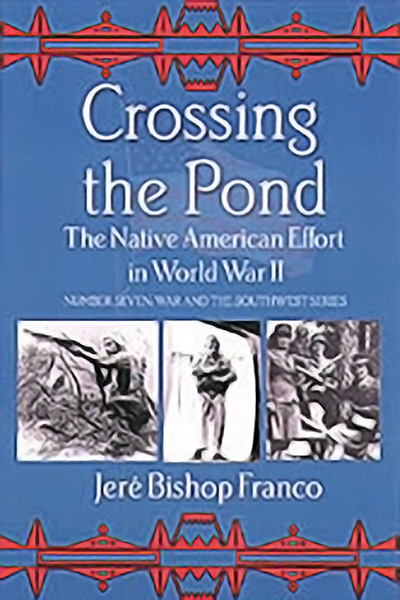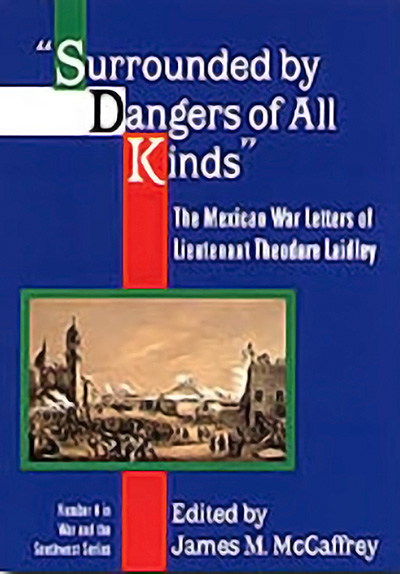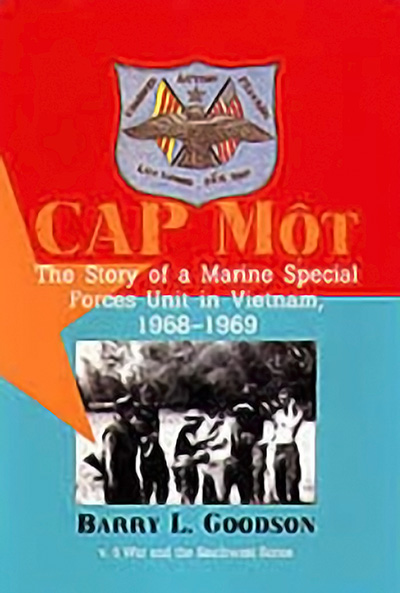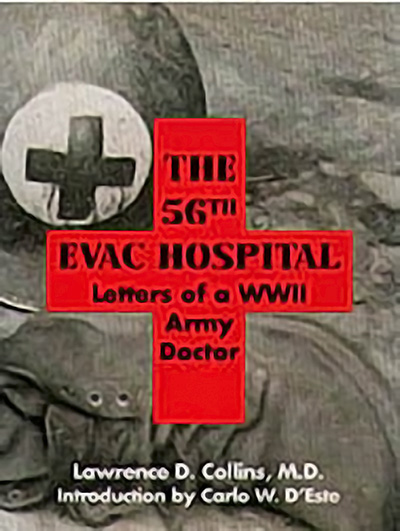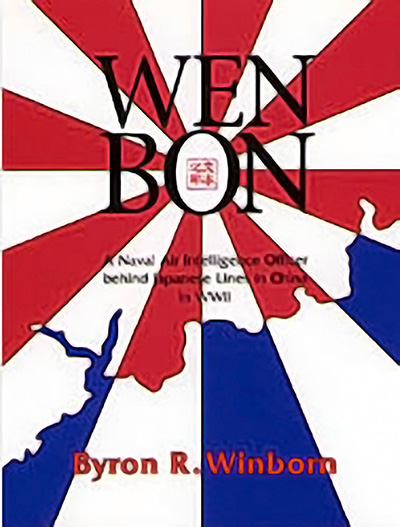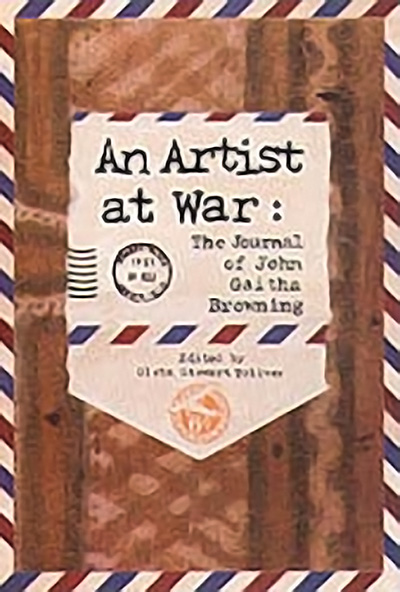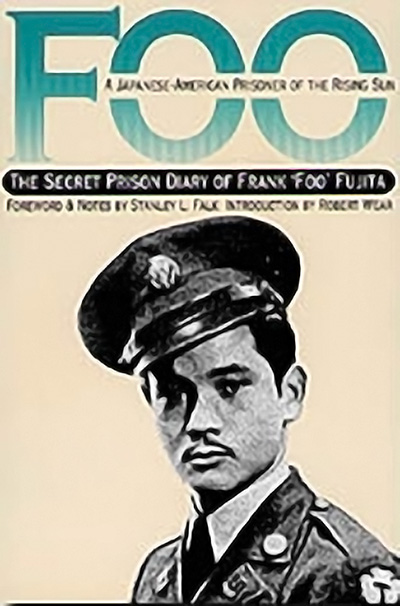Vol. 16: The Dallas Story: The North American Aviation Plant and Industrial Mobilization during World War II
Published: March, 2023 Pages: 416 Features: 25 b&w illus. Notes. Bib. Index.
Listen to an interview on The Bookmark with Terrance Furgerson, author of The Dallas Story more... about The Dallas Story: The North American Aviation Plant and Industrial Mobilization during World War II
Vol. 15: A Military History of Texas
Published: March, 2022 Pages: 448 Features: 26 b&w illus. 4 maps. Notes. Bib. Index.
Comprehensive in scope, A Military History of Texas provides the first single-volume military history of Texas from pre-Columbian clashes between Native American tribes to the establishment of the United States Space Force as the newest branch of the nation’s military in the twenty-first century. Loyd Uglow ties the various engrossing aspects of Texas military history into one unified experience. more... about A Military History of Texas
Vol. 14: From the Halls of the Montezumas: Mexican War Dispatches from James L. Freaner, Writing under the Pen Name "Mustang"
Published: October, 2019 Pages: 576 Features: 31 b&w illus. 3 maps. Notes. Bib. Index.
James L. Freaner was one of America’s first war correspondents covering General Winfield Scott’s campaign during the Mexican War. His letters appeared in newspapers under the byline “Mustang,” and his reports from the front included publication of complete casualty lists (long before official reports became public), detailed battle descriptions, and observations on postwar Mexico. Freaner’s greatest contribution was persuading Nicholas P. Trist, negotiator with Mexico, to ignore his recall and conclude a peace treaty that added California, Nevada, Utah, and other territory to a growing country. more... about From the Halls of the Montezumas: Mexican War Dispatches from James L. Freaner, Writing under the Pen Name "Mustang"
Vol. 13: Ordered West: The Civil War Exploits of Charles A. Curtis
Published: June, 2017 Pages: 704 Features: 31 b&w illus. 4 maps. Notes. Bib. Index.
During the Civil War, Charles Curtis served in the 5th United States Infantry on the New Mexico and Arizona frontier. He spent his years from 1862 to 1865 on garrison duty, interacting with Native Americans, both hostile and friendly. Years after his service and while president of Norwich University, Curtis wrote an extensive memoir of his time in the Southwest. Curtis’s reminiscences detail his encounters with Indians, notable military figures, eccentrics, and other characters from the Old West—including Kit Carson—as well as the construction of Fort Whipple and expeditions against the Navajo and Apache. more... about Ordered West: The Civil War Exploits of Charles A. Curtis
- Finalist for the 2018 New Mexico-Arizona Book Awards in Biography
Vol. 12: Civil War General and Indian Fighter James M. Williams: Leader of the 1st Kansas Colored Volunteer Infantry and the 8th U.S. Cavalry
Published: May, 2013 Pages: 320 Features: 37 b&w photos. 3 maps. Notes. Bib. Index.
The military career of General James Monroe Williams spanned both the Civil War and the Indian Wars in the West, yet no biography has been published to date on his important accomplishments, until now. From his birth on the northern frontier, westward movement in the Great Migration, rush into the violence of antebellum Kansas Territory, Civil War commands in the Trans-Mississippi, and as a cavalry officer in the Indian Wars, Williams was involved in key moments of American history. Like many who make a difference, Williams was a leader of strong convictions, sometimes impatient with heavy-handed and sluggish authority. more... about Civil War General and Indian Fighter James M. Williams: Leader of the 1st Kansas Colored Volunteer Infantry and the 8th U.S. Cavalry
- William Henry Seward Award for Excellence in Civil War Biography, Civil War Forum of Metropolitan New York, 2014
Vol. 11: They Called Them Soldier Boys: A Texas Infantry Regiment in World War I
Published: March, 2013 Pages: 352 Features: 21 b&w photos. 5 maps. Notes. Bib. Index.
They Called Them Soldier Boys offers an in-depth study of soldiers of the Texas National Guard’s Seventh Texas Infantry Regiment in World War I, through their recruitment, training, journey to France, combat, and their return home. Gregory W. Ball focuses on the fourteen counties in North, Northwest, and West Texas where officers recruited the regiment’s soldiers in the summer of 1917, and how those counties compared with the rest of the state in terms of political, social, and economic attitudes. Through the use of Selective Service Registration cards, a sample of 1,096 members of the regiment provides enough data to suggest a portrait of the officers and enlisted men based on age, occupation, marital status, dependents, and other criteria, an approach common to analyses of soldiers in other wars but which has not been done before in studies of World War I soldiers. more... about They Called Them Soldier Boys: A Texas Infantry Regiment in World War I
- Winner of two Communicator Awards for Cover (overall) and Cover (design), 2013
Vol. 10: The Seventh Star of the Confederacy: Texas during the Civil War
Published: March, 2010 Pages: 464 Features: 23 b&w illus. 4 maps. Notes. Bib. Index.
On February 1, 1861, delegates at the Texas Secession Convention elected to leave the Union. The people of Texas supported the actions of the convention in a statewide referendum, paving the way for the state to secede and to officially become the seventh state in the Confederacy. Soon the Texans found themselves engaged in a bloody and prolonged civil war against their northern brethren. During the course of this war, the lives of thousands of Texans, both young and old, were changed forever. more... about The Seventh Star of the Confederacy: Texas during the Civil War
- The A. M. Pate, Jr. Award in Civil War History, 2009
Vol. 9: Spartan Band: Burnett's 13th Texas Cavalry in the Civil War
Published: August, 2010 Pages: 272 Features: 7 b&w photos. 8 maps. Notes. Bib. Index.
In Spartan Band (coined from a chaplain’s eulogistic poem) author Thomas Reid traces the Civil War history of the 13th Texas Cavalry, a unit drawn from eleven counties in East Texas. The cavalry regiment organized in the spring of 1862 but was ordered to dismount once in Arkansas. The regiment gradually evolved into a tough, well-trained unit during action at Lake Providence, Fort De Russy, Mansfield, Pleasant Hill, and Jenkins’ Ferry, as part of Maj. Gen. John G. Walker’s Texas division in the Trans-Mississippi Department. more... about Spartan Band: Burnett's 13th Texas Cavalry in the Civil War
Vol. 8: The Royal Air Force in Texas: Training British Pilots in Terrell during World War II
Published: October, 2009 Pages: 208 Features: 25 illus. Notes. App. Bib. Index.
With the outbreak of World War II, British Royal Air Force (RAF) officials sought to train aircrews outside of England, safe from enemy attack and poor weather. In the United States six civilian flight schools dedicated themselves to instructing RAF pilots; the first, No. 1 British Flying Training School (BFTS), was located in Terrell, Texas, east of Dallas. more... about The Royal Air Force in Texas: Training British Pilots in Terrell during World War II
Vol. 7: Crossing the Pond: The Native American Effort in World War II
Published: April, 1999 Pages: 296 Features: 15 b&w photos. Bib. Index
“Crossing the Pond” is a term Native Americans used to describe the process of being transferred overseas for military duty. This was both an event and a duty taken quite seriously by tribal members, who participated in every aspect of wartime America. On the homefront, Native Americans gave comparable and sometimes exemplary contributions to civilian defense work, Red Cross drives, and war bond purchases. more... about Crossing the Pond: The Native American Effort in World War II
Vol. 6: "Surrounded by Dangers of all Kinds": The Mexican War Letters of Lieutenant Theodore Laidley
Published: October, 1997 Pages: 240 Features: 1 photo. 2 illus.Bib. Index. Open Access
“Surrounded by Dangers of All Kinds”: The Mexican War Letters of Lieutenant Theodore Laidley is now available as a free e-book at the UNT Digital Library and The Portal to Texas History. more... about "Surrounded by Dangers of all Kinds": The Mexican War Letters of Lieutenant Theodore Laidley
Vol. 5: CAP Mot: The Story of a Marine Special Forces Unit in Vietnam, 1968-1969
Published: March, 1997 Pages: 384 Features: 28 b&w photos. 4 illus. map. Index.
The Marines’ Combined Action Platoon program—CAP—was one of the most innovative approaches to pacification used in Vietnam. From experience in other civil wars in Haiti, Nicaragua, and the Dominican Republic, the Marine Corps believed that firepower alone would not subdue the enemy, that the people had to be won over. Consisting of a volunteer rifle squad, a Navy medical corpsman and a locally recruited platoon of Popular Forces (PF), the CAP lived among the villagers 24 hours a day for the express purpose of protecting and helping them to survive the dangers of their enemies. They also were to help them improve their health and their daily lives. more... about CAP Mot: The Story of a Marine Special Forces Unit in Vietnam, 1968-1969
Vol. 4: The 56th Evac Hospital: Letters of WWII Army Doctor
Published: February, 1995 Pages: 352 Features: 40 photos. Map. Bib. Index.
“I see no way that we junior officers will ever be prepared for any major surgery… We’ll have to perform major surgery on our own, ready or not.” —Dr. L. D. Collins at the beginning of his tour of duty with the 56th Evacuation Hospital (a mobile tent hospital similar to the M*A*S*H units of Korean War fame), largely staffed by men and women trained at Baylor University College of Medicine in Dallas more... about The 56th Evac Hospital: Letters of WWII Army Doctor
Vol. 3: Wen Bon: A Naval Air Intelligence Officer behind Japanese Lines in China in WWII
Published: November, 1994 Pages: 253 Features: 25 b&w photos. maps. gloss. Index.
“Highly recommended for its rich adventurous story.” - Reader’s Review, The Bookseller’s Network more... about Wen Bon: A Naval Air Intelligence Officer behind Japanese Lines in China in WWII
Vol. 2: An Artist at War: The Journal of John Gaitha Browning
Published: September, 1994 Pages: 304 Features: 4 maps. 20 illus.
When twenty-nine-year-old artist John Gaitha Browning enlisted in 1942, he was determined to keep a journal recording his observations of army life—from boot camp to combat. more... about An Artist at War: The Journal of John Gaitha Browning
Vol. 1: FOO: A Japanese-American Prisoner of the Rising Sun: The Secret Prison Diary of Frank "FOO" Fujita
Published: March, 1993 Pages: 350 Features: 35 b&w photos. Maps. 47 Illus. Bib. Index.
“This work is quite different and is unique in that it chronicles the internment of the only Japanese-American combat soldier captured during the Pacific campaign of World War II. Frank “Foo” Fujita, a Texan who served with the “Lost Battalion” of the 36th Infantry Division, was captured during the defense of Java in early 1942… Despite the subject, the book reveals much of the humor of Fujita and his comrades… Foo is refreshing in that it never deviates from its view of the Japanese as the aggressors and barbarians of the Pacific War—the view of a Japanese-American who served his country with dignity and honor.” —Southwestern Historical Quarterly more... about FOO: A Japanese-American Prisoner of the Rising Sun: The Secret Prison Diary of Frank "FOO" Fujita
- New York Public Library Book to Remember, 1994
- American Library Association Notable Books List, 1993
